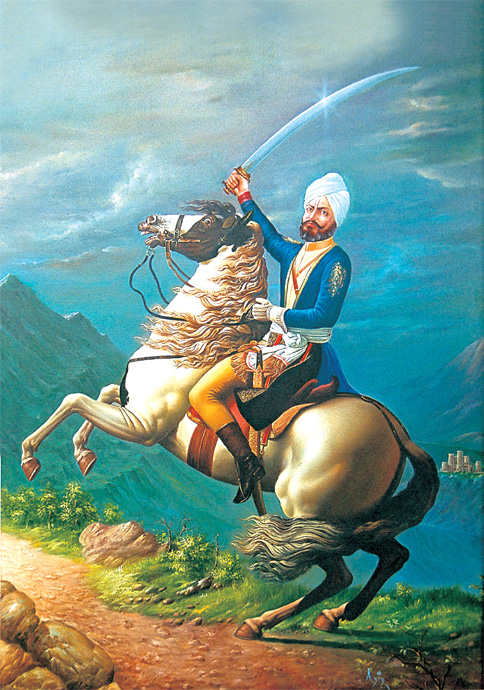IDR Blog
Trans-Himalayan Campaigns of Gen Zorawar Singh

Gen Zorawar Singh was born on 15 April 1786 at Kahlur, in neighboring Himachal. Later as General of Jammu Raja Gulab Singh, he launched Trans-Himalayan campaigns starting on 15 April 1834 with an army of 5000 and within 8 years conquered Ladakh, Gilgit-Baltistan and Western Tibet. His Martyrdom on 12 December 1841 ended a saga of remarkable valour of a legendary military commander who took Indian boundaries up to Central Asian Republics. But Prof. R R Sharma’s article “Amazing Vision of Jammu : Janus Faced” in Daily Excelsior on 28 – 11- 2020, wherein he has belittled Gen Zorawar Singh and cast aspersions on those military historians who have called him ‘Napoleon of the East’, left me nonplussed. That prompts me to highlight his Trans-Himalayas conquests to undo the damage done by Prof Sharma. Prof Sharma says, “Gen Zorawar Singh won the battles against smaller forces. When confronted with a large force he succumbed whereas Napoleon conquered entire Europe but got defeated at the hands of Russians because of severe winter. Hence Gen Zorawar Singh stands too small to be compared with Napoleon”. Whereas contrary is the case. In December 1841 Gen Zorawar Singh fought in minus 40 t0 50 Degree temperature. Russian and Moscow’s terrain and climate is certainly not as bad as Himalayan. Coming to the comparison, Napoleon attacked Russia in September 1812 with 6,85,000 massive army out of which 4 Lakh were French whereas Zorawar Singh marched into Tibet with 5,000 soldiers. In the face of Great French Army, Russians followed a strategy of fighting withdrawal inflicting heavy casualties on attacking forces to the tune of bloodiest 72,000 casualties a single day. After the final attack on Moscow, in late November, barely a lakh survived. French Army had 3,80,000 dead and rest captured/missing. After this defeat Napoleon returned to Paris to save his throne. Russian campaign ended on 14 December 1812 which ended French hegemony over Europe and led to Napoleon’s exile and final Waterloo. Napoleon’s ‘great army’ was defeated by lesser Russian army despite better logistic support (army marches on its stomach) and under comparatively better climatic conditions. Gen Zorawar Singh unexpectedly faced a composite Chinese and Tibetan force during worst climatic conditions and lost. Hence achievements wise comparison of two great military leaders is reasonable. Historians have the luxury of misrepresenting facts but ultimately judgment lies with intellectuals. Admiringly Prof Suresh Chander has brought the truth out by his article in Daily Excelsior on 2nd December 2020 proving that Jammu’s vision is not ‘Janus Faced’ but Prof Sharma’s one face sees Jammu with planted eyes and the other with own.
Let me recount Gen Zorawar Singh’s Trans-Himalayan adventures for the readers to judge. Table-land Ladakh and Gilgit-Baltistan were the main objective of Jammu ruler because the ancient Silk Route passed through their capital towns Leh and Skardu. The average height of the area was 12,000 ft where air was rarified, lacking oxygen and making breathing difficult. During the winter, rivers freeze, passes get blocked and tracks get covered with snow. Snow storms and blizzards were common phenomenon. Food crops, fodder and fuel was not enough even for the local population. Hence the terrain, climate and altitudes made living and logistics difficult to support a military adventure.
In 1834 the Raja of Timbus, sought Raja Gulab Singh’s help against Ladakhi King. Finding the opportunity, Raja Gulab Singh ordered his able commander Zorawar Singh to march into Ladakh. The Dogra General had been waiting for such opportunity to excel. Gen Zorawar Singh entered Ladakh through the Suru River where he defeated a local army of General Mangal and established Dogra control over Western province of Purig by mid August. After a brief pause to refurbish his force, the Dogra Commander marched towards Leh. King sent Gen Banko Kahlon to cut off Zorawar Singh’s lines of communication. The astute Dogra General rushed back to Kartse where he sheltered his troops through the winter. In the spring of 1835, he defeated 22,000 strong Army of Gen Kahlon and marched his victorious troops to Leh. The panic stricken King sued for peace. As per the agreement, he was retained as King with Ladakh as vassal state of the Dogra Kingdom. Soon after the two sides had signed the peace agreement, the Chief of Sod rose in arms against the Dogras. Dogra General quickly suppressed the revolt. Having restored order, Zorawar Singh triumphantly returned to Jammu at the end of 1835. This is considered as one of the greatest victories of Gen Zorawar Singh.
The impressive Dogra victory over Ladakh aroused uneasiness at Lahore Darbar. It made Sikhs apprehensive of Jammu Raja’s designs. Placating Lahore’s misgivings over Ladakh, Raja Gulab Singh told his overlord Maharaja Ranjit Singh that his expedition had actually helped expand Sikh empire. Gen Zorawar Singh also met the Emperor on 16 March 1836 to explain about Ladakh campaign. He put forth his plans to carry the Sikh empire Flag still further into Gilgit-Baltistan, Tibet and China. This startled the emperor but bolstered his confidence in him. In 1837, on the instigation of Mahan Singh, the Sikh Governor of Kashmir, Ladakh King revolted against Jammu’s authority. This forced Gen Zorawar Singh’s return to Leh speedily. Moment he reached Leh, the King begged for forgiveness. Dogra General exploited Ladakh’s internal feuds to his advantage and forced King to abdicate in favor of a noble Ngorub Stabzin. Appointing Ngorub as the ruler, he returned to Jammu.
In 1838, Ngorub also revolted. Zorawar Singh marched back to Leh via Zanskar. Ngorub was deposed and original King Tse-Pal was re-installed. In 1839, Zorawar Singh returned to Ladakh yet again to face another challenge from the ousted Ngorub. Dogras promptly suppressed the rebellion, arrested the leading insurgents and returned to Jammu. In 1840, Sukamir of Purig raised the banner of rebellion against Jammu. Zorawar Singh reappeared in Ladakh 5th time and this time brutally suppressed the rebellion.
With Ladakh firmly under control, the challenge lay to the Northwest which was predominantly a Muslim region under Afghan patronage. Maharaja Ranjit Singh’s death in 1839 gave Jammu ruler a free rein in Himalayas. Encouraged by the rifts amongst various Principalities and Royal households, Raja Gulab Singh ordered Zorawar Singh to invest Baltistan. With an army of 15,000, comprising of Dogras and Ladakhis, Dogra General marched to Baltistan at the end of 1840. His bold speed-march in winters and crossing Indus over frozen waters caught the Baltis off-guard and decisively beaten enabling Gen Zorawar Singh reach Balti capital of Skardu and besiege its strategic Fort.
Having consolidated his reign in Gilgit-Baltistan, Raja Gulab Singh revived an ancient Ladakhi claim over Western Tibet and in May 1841 let Gen Zorawar Singh enter highlands of Tibet with 5,000 men comprising of Dogras, Ladakhis & Baltis. Sweeping all resistance on the way, he passed the Mansarovar Lake and converged at Gartok. Tibetan commander fled to Taklakot. Zorawar Singh stormed Taklakot Fort on 6 September 1841 and captured the strategic city. Envoys from Tibet and Nepal met the General at Taklakot to negotiate peace. Unexpectedly, in November a composite army of 10,000 Chinese and Tibetans marched to Taklakot to drive Dogras from Tibet. The adversaries came face to face on 10 December. The fierce battle began. Temperature by then had fallen to minus 50 due to sweeping blizzards. Yet the Dogras gave a tough fight. On 12 December 1841, the Dogra General was fatally wounded. The death of the Force Commander decided the outcome of the battle. Living up to their bravery, Dogras executed the enemy General to avenge their commander’s martyrdom. On 12th December 1841 ended the saga of glorious military adventures of the Dogra Warrior. Tibetans raised a memorial for the fallen General which is visited by the pregnant women for blessings for a brave son, a rare honour extended nowhere else in the world leaves Napoleon far aside.
Of late, Sikh historians have started claiming Gen Zorawar Singh as Sikh and General of Maharaja Ranjit Singh and glorifying his achievements much more than any other historians has done. The fact that he was sent to Lahore Darbar by Jammu Raja after his Ladakh conquest to mollify Maharaja Ranjit Singh and later Kashmir Governor Mahan Singh instigating a revolt against Dogra rule in Ladakh refutes their claim of otherwise well orchestrated acclamation.
With the acclaimed Tibetan Campaign ending in December, the month is very sentimental and special to Indian Army. By December 1947, Indian Army had pushed the Pakistani invaders back from Kashmir. It won both 1965 Indo-Pak and Bangladesh Wars in December month. Hence the month has rightly been declared as yearly ‘month of martyrs’ by Raksha Mantri Raj Nath Singh to commemorate the Indian Army for the sacrifices it has made for the motherland to exhort the nation to celebrate it proudly.
Courtesy: https://www.dailyexcelsior.com/trans-himalayan-campaigns-of-gen-zorawar-singh/




